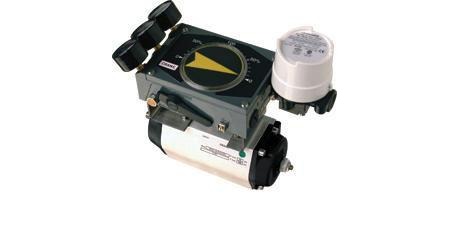Valve positioners can provide process operators with a precise degree of valve position control across the valve movement range, as well as information about valve position. A relationship exists between applied pneumatic signal pressure and the position of the valve trim. The relationship between the two elements is dependent upon the valve actuator and the force of the return spring reacting to the signal pressure. In a perfect world, the spring and pneumatic forces would reach equilibrium and the valve would return to the same position in response to an applied signal pressure. There are other forces, however, which can act upon the mechanism, meaning the expected relationship between the original two elements of pressure and position may be offset. For example, the packing of the valve stem may result in friction, or the reactive force from a valve plug resulting from differential pressure across the area of the plug may be another.
While these elements may seem minor, and in some cases they are, process control is about reducing error and delivering a desired or planned output. Inclusion of a positioner in the valve assembly can ensure that the valve will be set in accordance with the controller commands.
Each positioner functions as a self-contained small scale control system. The first variable in the positioning process is the current valve position, read by a pickup device incorporated in the positioner. A signal which is sent to the positioner from the control system, indicating the desired degree of opening, is used as the setpoint. The controller section of the positioner compares the current valve position to the setpoint and generates a signal to the valve actuator as the output of the positioning process. The process controller delivers a signal to the valve, and then the positioner takes that signal and supplies air pressure required to accomplish the needed adjustment of the stem position. The job of the valve positioner is to provide compensatory force and to act as a counterbalance against any other variables which may impact valve stem position.
Magnetic sensors can be employed to determine the position of the valve stem. The magnetic sensor works by reading the position of a magnet attached to the stem of the valve. Other technologies can be employed, and all have differing ways of overcoming degrees of inaccuracy which may arise with wear, interference, and backlash. In addition to functioning as a positioner, control valve positioning devices can also function as volume boosters, meaning they can source and subsequently ventilate high air flow rates from sources other than their pneumatic input signal (setpoint). These devices can positively affect and correct positioning and velocity of the valve stem, resulting in faster performance than a valve actuator solely reliant on a transducer.
The inclusion of a positioner in a control valve assembly can provide extended performance and functionality that deliver predictable accurate valve and process operation. Share your valve automation requirements with a knowledgeable specialist and combine your process knowledge and experience with their product application expertise to develop an effective solution.
